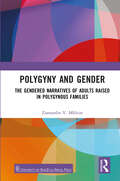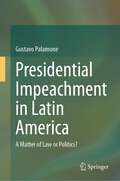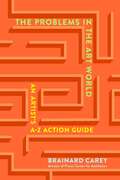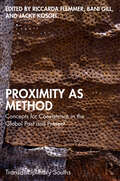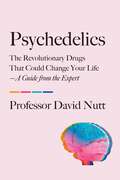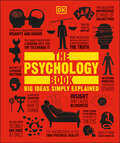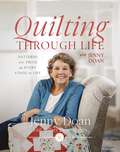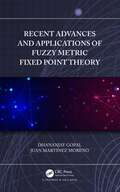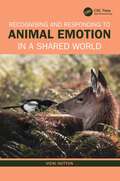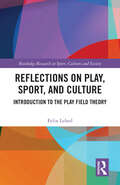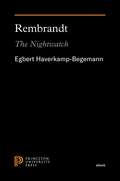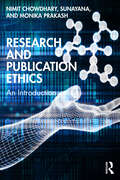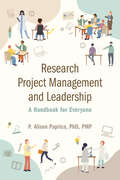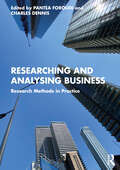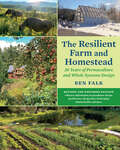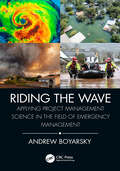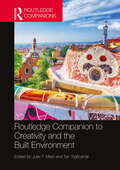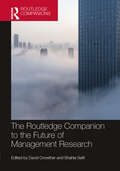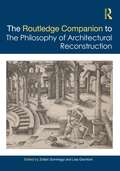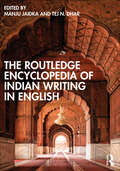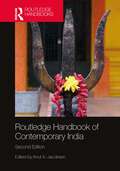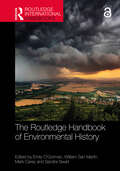- Table View
- List View
Polygyny and Gender: The Gendered Narratives of Adults Raised in Polygynous Families
by Zamambo V. MkhizeThe people of Africa have contrasting perspectives on gender, feminism, and the family from their Western counterparts. Similarly, social structures like, religion, capitalism and the law require a context-specific application to polygyny. This book examines the construction of gender identity in adults raised in Zulu polygynous families in the Hammarsdale area in KwaZulu-Natal, South Africa. It highlights the complexities of gender identities as participants negotiate between modern, constitutional, and individual freedoms and patriarchal, cultural, and communal customs and traditions. The themes also point towards the argument between individuality and collectivism in the creation of gender identity within polygynous families in Zulu culture. The South African Constitution guarantees gender equality and individual rights and freedoms for its citizens, yet customary law practices, like polygyny, appear to contravene these principles. The participants reveal that although women and men experience different consequences, they cite similar prevalent factors like gender role socialisation, naming practices and the doctrine of seniority, influencing their gender identity construction. Print edition not for sale in Sub Saharan Africa.
Presidential Impeachment in Latin America: A Matter of Law or Politics?
by Gustavo PalamoneThis book pursues a comparative and interdisciplinary approach to assess presidential impeachments in Latin America. Mixing methodologies from legal studies and political science, it provides a novel and comprehensive assessment of some of the most controversial questions regarding the constitutional function of impeachment and its place in the theory of government.Presidential impeachments have become frequent in Latin America, yet they are still largely misunderstood by legal practitioners and the general public. As such, impeachments frequently provide for heated and polarizing debates. The misunderstandings stem from skewed expectations arising from different theories of government, legal interpretation, and presidential impeachment. The empirical evidence and arguments presented here will help to find common ground on these topics and pacify some latent tensions in society and academia. In addition, the book’s case studies cover cases that have been rarely or incompletely addressed in the literature. Some cover events so recent that they have never been analyzed elsewhere.The book proposes reconsidering certain assumptions made about systems of government, which are based on skewed expectations of impeachments. It also draws on new evidence to re-examine existing impeachment theories and develop new ones. By doing so, it offers valuable insights that may guide lawmakers to redesign their own systems, optimizing them to achieve certain goals. It will also acquaint legal practitioners with the strategies of prosecution, defense, and decision-making in connection with impeachments.
The Problems in the Art World: An Artist's A-Z Action Guide
by Brainard CareyLearn how to navigate the turbulent seas of the art world from acclaimed art advocate Brainard Carey. In this succinct volume, author Brainard Carey, an artist with prestigious exhibitions like the Whitney Biennial under his belt, distills two decades of personal experience and over 1,900 interviews with artists and curators for Yale University Radio exploring the question of how to achieve, manage, and maintain art careers. In The Problems in the Art World: An Artist&’s A-Z Action Guide, Carey directly addresses the following key challenges every artist grapples with at some point: A. The problem of commitment B. The problem of getting recognition C. The problem of a community D. The problem with grants E. The problem with money F. The opportunities problem G. The scam problem H. The social media problem And much more! With a shareable illustrated format for easily taking action, The Problems in the Art World is an A-Z guide on the best paths to take and the best choices to make to survive and thrive in the unpredictable art world.
Proximity as Method: Concepts for Coexistence in the Global Past and Present (Transdisciplinary Souths)
by Riccarda Flemmer Bani Gill Jacky KosgeiThis book examines proximity as a benchmarked concept that can be deployed across a range of humanities disciplines to rethink the ways in which existences in the world are always already coexistences – and to parse the heuristic, ethical, epistemological, praxeological consequences of this recognition.The volume:- Brings together diverse theoretical approaches and utilizes a range of methodological instruments – conceptual, textual-analytic (whether in the realm of literary or religious studies, or theology or law), archival, digital, sociological or politological;- Includes empirical case-studies that allow calibrated and scaled exemplifications;- Launches forays onto unexplored conceptual terrain, or call into question hallowed truths of scholarly procedure.The volume will be essential reading for students and early researchers in the social sciences and the humanities.
Psychedelics: The Revolutionary Drugs That Could Change Your Life—A Guide from the Expert
by Professor David NuttThe definitive guide to the science of psychedelics—"the perfect intro for anyone curious about psychedelics and MDMA&” (Ethan Nadelmann, founder and former executive director, Drug Policy Alliance)--and how they can impact our health by world-renowned, leading authority Professor David Nutt. We are on the cusp of a major revolution in psychiatric medicine and neuroscience. After fifty years of prohibition, criminalization and fear, science is finally showing us that psychedelics are not dangerous or harmful. Instead, when used according to tested, safe and ethical guidelines, they are our most powerful newest treatment of mental health conditions, from depression, PTSD, and OCD to disordered eating and even addiction and chronic pain. Professor David Nutt, one of the world's leading Neuropsychopharmacologists, has spent 15 years researching this field and it is his most significant body of work to date. In 2018, he co-founded the first academic psychedelic research center - underpinned by his mission to provide evidence-based information for people everywhere. It revived interest in the understanding and use of this drug in its many forms, including MDMA, ayahuasca, magic mushrooms, LSD and ketamine. The results of this have been nothing short of ground-breaking for the future categorization of drugs, but also for what we now know about brain mechanisms and our consciousness. At a time where there is an enormous amount of noise around the benefits of psychedelics, this book contains the knowledge you need to know about a drug that is about to go mainstream, free from the hot air, direct from the expert. Are you ready to change your mind?
The Psychology Book: Big Ideas Simply Explained (DK Big Ideas)
by DKLearn about human nature, behavior and how the mind works with The Psychology Book.Part of the fascinating Big Ideas series, this book tackles tricky topics and themes in a simple and easy to follow format. Learn about Psychology in this overview guide to the subject, great for beginners looking to learn and experts wishing to refresh their knowledge alike! The Psychology Book brings a fresh and vibrant take on the topic through eye-catching graphics and diagrams to immerse yourself in. This captivating book will broaden your understanding of Psychology, with:More than 100 ground-breaking ideas in this field of sciencePacked with facts, charts, timelines and graphs to help explain core conceptsA visual approach to big subjects with striking illustrations and graphics throughoutEasy to follow text makes topics accessible for people at any level of understandingThe Psychology Book is the perfect introduction to the science, aimed at adults with an interest in the subject and students wanting to gain more of an overview. Here you’ll discover key concepts by psychologists who have significantly enhanced our understanding of the human mind and behavior. Learn about everyone who’s contributed to the big ideas in psychology, incorporating the ideas of today’s scientists as well those of the ancient philosophers and pioneers. Your Psychological Questions, Simply ExplainedIf you thought it was difficult to learn psychology and its many concepts, The Psychology Book presents the key ideas in a clear layout. Learn about the key personalities of the 19th and 20th centuries whose work has made significant contributions to our understanding of human behavior. Fantastic mind maps and step-by-step summaries explain the line of thought clearly for students of psychology and for anyone with a general interest in understanding the human mind.The Big Ideas SeriesWith millions of copies sold worldwide, The Psychology Book is part of the award-winning Big Ideas series from DK. The series uses striking graphics along with engaging writing, making big topics easy to understand.
Quilting Through Life: Patterns and Prose for Every Stage of Life (Spiral Bound to Lay Flat)
by Jenny DoanStep-by-step quilting instructions and personal stories to inspire both seasoned pros and new quilters alike.America's quilter, Jenny Doan, has always believed that quilts are more than fabric and stitches. They become keepers of memories, milestones, and stories; creating profound connections across generations.By alternating personal stories with detailed step-by-step guidance on how you can make quilts for all of life's milestones—from new births, to marriages, to loss and grief—Jenny comes alongside you to share the joy and transformative power of quilting in her passionate and innovative way.With beautiful, full-color images and easy-to-follow diagrams to help you with your own projects, Quilting Through Life is a creative and authentic guidebook to the art of quilting. It's an art designed to be shared with family and friends, crafted from the scraps of memories, laughter, and tears. It's an art that allows us to express how we feel, create something beautiful, and extend the warmth in our hearts to wrap around those we love.From choosing your fabrics and selecting a pattern to creating mitered corners, Quilting Through Life will walk you through how to stitch a legacy of love for every stage of life.
Recent Advances and Applications of Fuzzy Metric Fixed Point Theory
by Dhananjay Gopal Juan Martinez MorenoThis book not only presents essential material to understand fuzzy metric fixed point theory, but also enables the readers to appreciate the recent advancements made in this direction. It contains seven chapters on different topics in fuzzy metric fixed point theory. These chapters cover a good range of interesting topics such as con- vergence problems in fuzzy metrics, fixed figure problems, and applications of fuzzy metrics. The main focus is to unpack a number of diverse aspects of fuzzy metric fixed point theory and its applications in an understandable way so that it could help and motivate young graduates to explore new avenues of research to extend this flourishing area in different directions. The discussion on fixed figure problems and fuzzy contractive fixed point theorems and their different generalizations invites active researchers in this field to develop a new branch of fixed point theory. Features: Explore the latest research and developments in fuzzy metric fixed point theory. Describes applications of fuzzy metrics to colour image processing. Covers new topics on fuzzy fixed figure problems. Filled with examples and open problems. This book serves as a reference book for scientific investigators who want to analyze a simple and direct presentation of the fundamentals of the theory of fuzzy metric fixed point and its applications. It may also be used as a textbook for postgraduate and research students who try to derive future research scope in this area.
Recognising and Responding to Animal Emotion in a Shared World
by Vicki HuttonHow is it that depending on the setting, the same cat can be perceived as a homeless annoyance, a potential research subject or a thinking and feeling family member? The answer is bound up in our perception of non-human animals’ capacity to experience emotions, and this book draws on contemporary evidence-based research, observations, interviews and anecdotal case scenarios to explore the growing knowledge base around animal emotion. Acknowledging that animals can experience feelings directly affects the way that they are perceived and treated in many settings, and the author explores the implications when humans apply – or ignore – this knowledge selectively between species and within species. This information is presented within the unique context of a proposed hierarchy of perceived non-human animals' emotional abilities (often based on human interpretation of the animal’s emotional capacity), with examples of how this manifests at an emotional, spiritual and moral level. Implications for specific groups living with, caring for or working with non-human animals are examined, making the book of particular interest to those working, studying or researching in the veterinary professions; animal ethics, law and welfare; and zoology, biology and animal science. This book will also be fascinating reading for anyone interested in simply learning more about the animals with whom we share this planet. For some readers, it will validate the reciprocal emotional bond they feel for living creatures. For others, it will raise questions about the moral treatment of sentient non-human beings, breaking down the human protective barrier of cognitive dissonance and activating a cycle of change.
Reflections on Play, Sport, and Culture: Introduction to the Play Field Theory (Routledge Research in Sport, Culture and Society #141)
by Felix LebedThe psychological dependence of humanity on playing is huge. Its nature and functional utility are unclear. These linked yet contradictory issues have created the intrigue that has fed philosophical thought for more than two hundred years. During this period, philosophy transferred many of the subjects of its analysis to the aegis of the humanities that it spawned. Each of them pays close attention to human play and studies it with its own methods of theoretical and experimental research. Thus, what was once a general philosophical comprehension of human play has branched out into different directions, definitions, and theories. This new book represents a renewed general view of human play. The unique quality of the volume lies in its fairly rare interdisciplinary methodology, encompassing a broad spectrum of the humanities: philosophy, anthropology, sociology, and the history of play, and behavioral analysis of playing, which have been done by the author. As a result, the volume ends with the proposition of a new general approach to human play that is named by the author “play field theory”. Such an approach makes reflections on play, sport, and culture a source for all scholars studying play, by widening their knowledge through both a new general view and their familiarization with notions from neighboring fields and disciplines.
Rembrandt: The Nightwatch
by Egbert Haverkamp-BegemannA landmark book that casts critical light on one of Rembrandt&’s most iconic paintingsIn The Nightwatch, Rembrandt turns his portrayal of eighteen prominent Amsterdam citizens as members of a militia company into one of the world&’s most fascinating works of art, one that evokes censure as well as praise. The painting, however, was not an eccentric vision but a thoughtful reworking of a longstanding tradition of militia portraiture. In this classic book, Egbert Haverkamp-Begemann shows how Rembrandt chose motifs, colors, actions, and setting to emphasize the historic role of the militia in Amsterdam and the social standing of the men portrayed, and how contemporary viewers associated costumes and actions with events of the past and familiar circumstances of the period when the painting was made. Meticulously reconstructing the artist&’s intentions and the viewer&’s response, Haverkamp-Begemann sheds critical light on the startling young woman in gold and other visual elements of this remarkable work.
Research and Publication Ethics: An Introduction
by Nimit Chowdhary Sunayana Monika PrakashThis book provides a comprehensive overview of research and publication ethics and guides young researchers on how to conduct ethical research and publish their work responsibly. It presents an understanding of ethical practices in research and how they apply to research and publication by examining the different ethical theories and their application. The book also discusses the different factors influencing ethical decision-making and probes into the ethical issues that can arise in the research process. It explores the different forms of scientific misconduct, such as data fabrication and falsification, plagiarism, and conflicts of interest, and provides strategies for ethical research. The book also details the impact of scientific misconduct on research and publication and the strategies for preventing and detecting misconduct.Aligning to the belief that promoting ethical research practices is essential for advancing science and society, this book will be helpful for young researchers, scholars, aspiring researchers, and academicians interested in ethical research practices in multiple disciplines.
Research Project Management and Leadership: A Handbook for Everyone
by P. Alison PapricaThe project management approaches, which are used by millions of people internationally, are often too detailed or constraining to be applied to research. In this handbook, project management expert P. Alison Paprica presents guidance specifically developed to help with the planning, management, and leadership of research. Research Project Management and Leadership provides simplified versions of globally utilized project management tools, such as the work breakdown structure to visualize scope, and offers guidance on processes, including a five-step process to identify and respond to risks. The complementary leadership guidance in the handbook is presented in the form of interview write-ups with 19 Canadian and international research leaders, each of whom describes a situation where leadership skills were important, how they responded, and what they learned. The accessible language and practical guidance in the handbook make it a valuable resource for everyone from principal investigators leading multimillion-dollar projects to graduate students planning their thesis research. The book aims to help readers understand which management and leadership tools, processes, and practices are helpful in different circumstances, and how to implement them in research settings.
Researching and Analysing Business: Research Methods in Practice
by Pantea Foroudi Charles DennisResearching and Analysing Business: Research Methods in Practice provides an accessible and practical guide to various data collection and data analysis techniques within management, from both quantitative and qualitative perspectives. This key resource functions as a comprehensive reference tool – covering a broad variety of methodologies – examining both the theory behind them and their application in practice. These include systematic literature review through bibliometric and meta-analysis, secondary vs primary sources, qualitative research vs quantitative research, combining qualitative and quantitative methods, qualitative and quantitative research method approaches, fsQCA, data mining, and sentiment analysis. Chapters are rich in examples, data sets, practical exercises, easy-to-follow slides, and a glossary, which help readers to understand and apply research approaches as well as to assess the strengths and weaknesses of each method. Unique in its practical approach and with insights from active researchers, this book is required and recommended reading for advanced undergraduate and postgraduate students studying research methods as a core module within business and management courses. It is also a useful tool for PhD students and academics within the discipline. Online support materials include PowerPoint slides.
The Resilient Farm and Homestead, Revised and Expanded Edition: 20 Years of Permaculture and Whole Systems Design
by Ben Falk“This is one of the most practical, down-to-earth, dirt-under-the-fingernails, comprehensive explanations of all things homesteading and small farming. Whether you’re just dreaming or an old hand, Ben Falk’s longer experience horizon is invaluable.”—Joel Salatin, cofounder, Polyface Farm; author of Everything I Want to Do Is Illegal Informed by twenty years of successful land management and the professional design experience of his pioneering firm Whole Systems Design, LLC, author Ben Falk updates his classic text and delivers the definitive twenty-first century systems thinking manual in self-reliance—sure to empower readers to prioritize projects, make positive lifestyle decisions, and take strategic steps toward a regenerative future. In The Resilient Farm and Homestead, Revised and Expanded Edition Falk describes how he has transformed a degraded hillside in the frigid Vermont climate into a thriving, biodiverse Eden that now provides year-round abundance for his family and community. First published in 2013, The Resilient Farm and Homestead is a comprehensive how-to guide for building durable and productive land-based systems through the reciprocal interplay of humans and the natural world. In the ten years since he first published this seminal work, Falk has deepened his wisdom in harnessing nature-based solutions for increasingly challenging times, including addressing severe climate disruptions like drought and flood conditions. The book covers every strategy Falk and his team have tested on the Whole Systems Research Farms over the past two decades and includes detailed information on earthworks, gravity-fed water systems, soil fertility management, growing nutrient-dense food and medicine, fuelwood production, agroforestry, managed grazing, and much more. Complete with full-color photography and detailed design drawings, The Resilient Farm and Homestead, Revised and Expanded Edition includes new information on: Designing greenhouses and microclimates Reinvigorating human health and embodying a vigorous lifestyle Raising children on a homestead Creating failure-proof and resilient energy systems Focusing on permaculture beekeeping Cultivating proven cold climate plants Overcoming analysis paralysis and mastering the art of knowing where to start and when to take strategic risks And much, much more! In an age that feels defined by disconnection, disease, and decline, The Resilient Farm and Homestead, Revised and Expanded Edition offers a roadmap to conquering uncertainty, maximizing efficiency, and creating a bountiful, manageable landscape that will endure. “Essential reading for the serious prepper as well as for everyone interested in creating a more resilient lifestyle.”—Carol Deppe, author of The Resilient Gardener “This intelligent, challenging book, rooted somewhere between back-to-the-land idealism and radical survivalism, sees resilience as both planting and building for the use of future generations, but also as preparing food, water, shelter, and the human body and psyche for the onset of any imaginable extreme emergency. . . . The result is a comprehensive, open-ended, theoretical and practical system for a post-carbon-dependent life.”—Publishers Weekly (starred review of first edition)
Riding the Wave: Applying Project Management Science in the Field of Emergency Management (ISSN)
by Andrew BoyarskyEmergency managers and public safety professionals are more frequently being called on to address increasingly challenging and complex critical incidents, with a wider variety and intensity of hazards, threats, and community vulnerabilities. Much of the work that falls into the scope of emergency managers – prevention, preparedness, mitigation – is “blue sky planning” and can be contained and effectively managed within projects. This book provides a foundational project management methodology relevant to emergency management practice, and explains and demonstrates how project management can be applied in the context of emergency and public safety organizations.Special features include: an initial focus on risk assessment and identification of mitigation and response planning measures; a clear set of better practices, using a diverse set of examples relevant to today’s emergency environment, from projects to develop emergency response exercises to application development to hazard mitigation; a framework for managing projects at a strategic level and how to incorporate this into an organization’s program, and presents how to develop and manage an emergency program and project portfolio; and suitability as both a hands-on training guide for emergency management programs and a textbook for academic emergency management programs. This book is intended for emergency managers and public safety professionals who are responsible for developing emergency programs and plans, including training courses, job aids, computer applications and new technology, developing exercises, and for implementing these plans and components in response to an emergency event. This audience includes managers in emergency and first response functions such as fire protection, law enforcement and public safety, emergency medical services, public health and healthcare, sanitation, public works, business continuity managers, crisis managers, and all managers in emergency support functions as described by FEMA. This would include those who have responsibility for emergency management functions, even without the related title.
Rock Your Rupee: Where the Money Journey Begins
by Reena Saxena"Rock Your Rupee – Where the Money Journey Begins" by Reena Saxena is a comprehensive guide to financial literacy for youth, highlighting crucial concepts like money, wealth, income, and budgeting. Through relatable stories and practical examples, Saxena simplifies complex financial ideas, ensuring accessibility for young readers. The book emphasizes the significance of savings, wise investments, and distinguishing between needs and wants, equipping readers with tools for financial stability. By empowering youth with fundamental financial knowledge and practical strategies, "Rock Your Rupee" aims to cultivate responsible money management habits and pave the way for a secure financial future.
Routledge Companion to Creativity and the Built Environment (Routledge International Handbooks)
by Julie T. Miao Tan YigitcanlarThis book crtitically examines the reciprocal relationship between creativity and the built environment and features leading voices from across the world in a debate on originating, learning, modifying, and plagiarizing creativities within the built environment.The Companion includes contributions from architecture, design, planning, construction, real estate, economics, urban studies, geography, sociology, and public policies. Contributors review the current field and proposes new conceptual frameworks, research methodologies, and directions for research, policy, and practice. Chapters are organised into five sections, each drawing on cross-disciplinary insights and debates: Section I connects creativity, productivity, and economic growth and examines how our built environment stimulates or intimidates human imaginations. Section II addresses how hard environments are fabricated with social, cultural, and institutional meanings, and how these evolve in different times and settings. Section III discusses activities that directly and indirectly shape the material development of a built environment, its environmental sustainability, space utility, and place identity. Section IV illustrates how technologies and innovations are used in building and strengthening an intelligent, real-time, responsive urban agenda. Section V examines governance opportunities and challenges at the interface between creativity and built environment. An important resource for scholars and students in the fields of urban planning and development, urban studies, environmental sustainability, human geography, sociology, and public policy.
The Routledge Companion to the Future of Management Research (Routledge Companions in Business and Management)
by David Crowther Shahla SeifiThe management of organisations continues to evolve as new priorities emerge and new approaches are developed. Thus, it is clear that research into business and management will also continue to evolve. This will be in terms of both what is researched and in terms of the techniques and methods used to conduct research. Such development will continue into the future and this book highlights evolving areas. It also suggests new topics which are emerging and new techniques to conduct such research – topics and techniques that will be of benefit to researchers. The unique focus on the future of research methods in management, the emergence of topics in contemporary management and sustainability research and practices, such as sustainability and circular economy, will set this volume apart. With coverage of new and emerging subjects in management studies such as sustainability, zero carbon, green market, and circular economy, and the international collaboration with contributors from all around the globe, this major interdisciplinary reference volume will be of interest and great value to researchers, academics, and advanced students in the fields of business and management research and appropriate methodologies.
The Routledge Companion to the Future of Management Research (ISSN)
by David Crowther Shahla SeifiThe management of organisations continues to evolve as new priorities emerge and new approaches are developed. Thus, it is clear that research into business and management will also continue to evolve. This will be in terms of both what is researched and in terms of the techniques and methods used to conduct research. Such development will continue into the future and this book highlights evolving areas. It also suggests new topics which are emerging and new techniques to conduct such research – topics and techniques that will be of benefit to researchers. The unique focus on the future of research methods in management, the emergence of topics in contemporary management and sustainability research and practices, such as sustainability and circular economy, will set this volume apart.With coverage of new and emerging subjects in management studies such as sustainability, zero carbon, green market, and circular economy, and the international collaboration with contributors from all around the globe, this major interdisciplinary reference volume will be of interest and great value to researchers, academics, and advanced students in the fields of business and management research and appropriate methodologies.
The Routledge Companion to the Philosophy of Architectural Reconstruction
by Lisa Giombini Zoltán SomhegyiThis companion investigates the philosophical and theoretical foundations determining the conditions of possibility and the limits that make the conservation, readaptation, and transformation of past buildings legitimate operations.As increasing ecological and economic challenges question opportunities for new construction, the process of restoring, transforming, and readapting buildings for new or continued use is becoming an essential part of architectural practice. At the same time, the role of building conservation is changing from mere material preservation to being part of a broader strategy for social regeneration, eco-awareness, and inclusive urban planning. Chapters of this volume explore the complex set of considerations that inform decisions to merely preserve, accurately restore or variously reuse a building. They also look at the broader philosophical concerns such as ethical and aesthetic values, combined with ideas of heritage, history, and collective identity. Case studies on reconstruction after war, gentrification, the restoration of ancient edifices, reconstruction following the effects of climate change, and the use of technology solutions among many others, make this a timely and urgent volume.Adopting a broad transcultural perspective with contributions from five continents, the volume combines theoretical approaches with more practical, case study-based investigations and will be of great interest to upper-level students and academics working in the fields of architecture, conservation, urban design, aesthetics, and heritage management.
The Routledge Encyclopedia of Indian Writing in English
by Manju Jaidka Tej N. DharToday, Indian writing in English is a fi eld of study that cannot be overlooked. Whereas at the turn of the 20th century, writers from India who chose to write in English were either unheeded or underrated, with time the literary world has been forced to recognize and accept their contribution to the corpus of world literatures in English. Showcasing the burgeoning field of Indian English writing, this encyclopedia documents the poets, novelists, essayists, and dramatists of Indian origin since the pre-independence era and their dedicated works. Written by internationally recognized scholars, this comprehensive reference book explores the history and development of Indian writers, their major contributions, and the critical reception accorded to them. The Routledge Encyclopedia of Indian Writing in English will be a valuable resource to students, teachers, and academics navigating the vast area of contemporary world literature.
Routledge Handbook of Contemporary India
by Knut A. JacobsenThis revised and updated new edition of the Routledge Handbook of Contemporary India concentrates on India as it emerged after the economic reforms and the new economic policy of the 1980s and 1990s and as it develops in the twenty-first century. It presents new developments and advancements in the research literature and includes discussions of the major political change in India since the Hindu nationalist party Bharatiya Janata Party (BJP) came to power in 2014. This Handbook contains chapters by the field’s foremost scholars dealing with fundamental issues in India’s current cultural and social transformation. This new edition also contains six new chapters on topics not covered by the first edition, such as changes caused by the Hindu majoritarian political ideology, the Hinduization process in the northeast of India and contemporary Dalit and Adivasi literatures. Following an introduction by the editor, the book is divided into five parts: Part I: Foundation Part II: India and the world Part III: Society, class, caste and gender Part IV: Religion and diversity Part V: Cultural change and innovations Exploring the cultural changes and innovations relating a number of contexts in contemporary India, this Handbook is essential reading for students and scholars interested in Indian and South Asian culture, politics and society.
The Routledge Handbook of Environmental History (Routledge International Handbooks)
by Emily O’Gorman William San Martín Mark Carey Sandra SwartThe Routledge Handbook of Environmental History presents a cutting-edge overview of the dynamic and ever-expanding field of environmental history. It addresses recent transformations in the field and responses to shifting scholarly, political, and environmental landscapes. The handbook fully and critically engages with recent exciting changes, contextualizes them within longer-term shifts in the field, and charts potential new directions for study. It focuses on five key areas: Theories and concepts related to changing considerations of social justice, including postcolonial, antiracist, and feminist approaches, and the field’s growing emphasis on multiple human voices and agencies. The roles of non-humans and the more-than-human in the telling of environmental histories, from animals and plants to insects as vectors of disease and the influences of water and ice, the changing theoretical approaches and the influence of concepts in related areas such as animal and discard studies. How changes in theories and concepts are shaping methods in environmental history and shifting approaches to traditional sources like archives and oral histories as well as experiments by practitioners with new methods and sources. Responses to a range of current complex problems, such as climate change, and how environmental historians can best help mitigate and resolve these problems. Diverse ways in which environmental historians disseminate their research within and beyond academia, including new modes of research dissemination, teaching, and engagements with stakeholders and the policy arena. This is an important resource for environmental historians, researchers and students in the related fields of political ecology, environmental studies, natural resources management and environmental planning. Chapters 9, 10 and 26 of this book are freely available as a downloadable Open Access PDF at http://www.taylorfrancis.com under a Creative Commons Attribution-Non Commercial-No Derivatives (CC-BY-NC-ND) 4.0 license.
The Routledge Handbook of Environmental History (Routledge International Handbooks)
by Mark Carey Sandra Swart Emily O’Gorman William San MartínThe Routledge Handbook of Environmental History presents a cutting-edge overview of the dynamic and ever-expanding field of environmental history. It addresses recent transformations in the field and responses to shifting scholarly, political, and environmental landscapes.The handbook fully and critically engages with recent exciting changes, contextualizes them within longer-term shifts in the field, and charts potential new directions for study. It focuses on five key areas: Theories and concepts related to changing considerations of social justice, including postcolonial, antiracist, and feminist approaches, and the field’s growing emphasis on multiple human voices and agencies. The roles of non-humans and the more-than-human in the telling of environmental histories, from animals and plants to insects as vectors of disease and the influences of water and ice, the changing theoretical approaches and the influence of concepts in related areas such as animal and discard studies. How changes in theories and concepts are shaping methods in environmental history and shifting approaches to traditional sources like archives and oral histories as well as experiments by practitioners with new methods and sources. Responses to a range of current complex problems, such as climate change, and how environmental historians can best help mitigate and resolve these problems. Diverse ways in which environmental historians disseminate their research within and beyond academia, including new modes of research dissemination, teaching, and engagements with stakeholders and the policy arena. This is an important resource for environmental historians, researchers and students in the related fields of political ecology, environmental studies, natural resources management and environmental planning.Chapters 9, 10 and 26 of this book are freely available as a downloadable Open Access PDF at http://www.taylorfrancis.com under a Creative Commons Attribution-Non Commercial-No Derivatives (CC-BY-NC-ND) 4.0 license.
